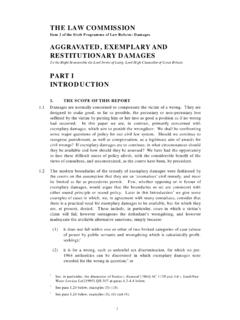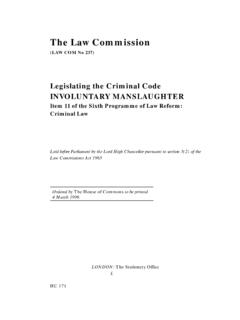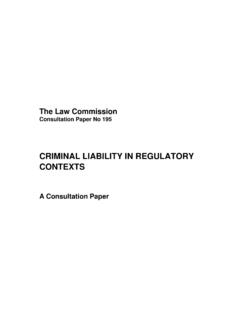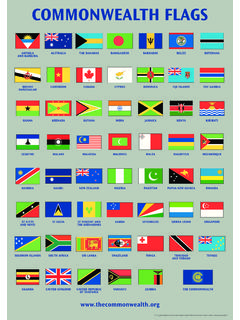Transcription of FORM AND ACCESSIBILITY OF THE LAW …
1 Form and ACCESSIBILITY of the Law Applicable in Wales Law Com No 366. The Law Commission (LAW COM No 366). FORM AND ACCESSIBILITY OF THE LAW. APPLICABLE IN WALES. Presented to Parliament pursuant to section 3(2) of the Law Commissions Act 1965. Ordered by the House of Commons to be printed on 29 June 2016. HC 469 I. Two volumes not to be sold separately Crown copyright 2016. This publication is licensed under the terms of the Open Government Licence except where otherwise stated. To view this licence, visit government-licence/version/3 or write to the Information Policy Team, The National Archives, Kew, London TW9 4DU, or email: Where we have identified any third party copyright information you will need to obtain permission from the copyright holders concerned.
2 This publication is available at Print ISBN 9781474135238. Web ISBN 9781474135245. ID 28061633 06/16 56140. Printed on paper containing 75% recycled fibre content minimum Printed in the UK by the Williams Lea Group on behalf of the Controller of Her Majesty's Stationery Office THE LAW COMMISSION. The Law Commission was set up by the Law Commissions Act 1965 for the purpose of promoting the reform of the law. The Law Commissioners are: The Right Honourable Lord Justice Bean, Chairman Professor Nick Hopkins Stephen Lewis Professor David Ormerod QC. Nicholas Paines QC. The Chief Executive of the Law Commission is Phil Golding.
3 The Law Commission is located at 1st Floor, Tower, 52 Queen Anne's Gate, London SW1H 9AG. The terms of this report were agreed on 15 June 2016. The text of this report is available on the Law Commission's website at to-wales/. iii THE LAW COMMISSION. FORM AND ACCESSIBILITY OF THE LAW. APPLICABLE IN WALES. CONTENTS. Paragraph Page Chapter 1: Introduction Introduction 1. This project 2. The context of the project 3. Consultation 8. The Constitutional and Legislative Affairs Committee Inquiry 9. The scope of this report 10. The cost of inaccessibility 11. The structure of this report 13. Chapter 2: Consolidation and codification Introduction 14.
4 Consolidation and codification 15. Chapter 3: Delivering consolidation, codification and law reform: procedures in the National Assembly Introduction 29. Legislative procedures 29. A National Assembly procedure for consolidation and 36. codification Non-controversial Law Commission law reform Bills 41. iv Introducing the procedures 42. Chapter 4: Maintaining codes Introduction 44. Distinguishing codes from Acts 44. A discipline to preserve codes 49. Chapter 5: Consolidating, codifying and amending secondary legislation 57. Introduction Improving the presentation of secondary legislation 58. Chapter 6: A codification programme and a Code Office A codification programme 60.
5 A Code Office 64. Chapter 7: Case studies Introduction 70. Case study 1: Education 70. Case study 2: Social care 71. Case study 3: Waste and the environment 72. Case study 4: Town and country planning 73. Case study 5: Local government 75. Other areas of law suggested for consolidation or codification 76. Conclusion 78. Chapter 8: Legislative standards Introduction 79. v Legislation committees in New Zealand 79. Legislative standards 81. A legislation committee for Wales? 85. Legislative impact assessments 91. keeling schedules 93. Explanatory Memoranda 97. Explanatory notes 99. Chapter 9: Drafting good legislation Introduction 104.
6 Drafting legislation 104. Chapter 10: Bilingual legislation Introduction 113. Welsh legal terminology 114. An Interpretation Act for Wales? 122. Chapter 11: Bilingual drafting Introduction 127. Institutional Arrangements for drafting legislation 128. The process of drafting bilingual legislation 129. Additional support for drafting legislation 135. Chapter 12: The interpretation of bilingual legislation Introduction 139. The approach to the interpretation of bilingual legislation in 139. English and Welsh vi Chapter 13: Official publication of legislation Introduction 151. Responsibility for publishing legislation 151.
7 Accessing Welsh language legislation online 157. Displaying the territorial application of legislation 160. Presentation of explanatory notes 163. Open source editing 164. Chapter 14: A legal website for Wales Introduction 166. Current services in Wales 166. A separate legislation database for Wales? 166. Search engine optimisation 167. Accessing legislation by subject matter 169. Publishing official guidance 172. Commentary explaining the law 174. Chapter 15: Legal education and textbooks Legal education 176. Textbooks on the law applicable in Wales 179. Chapter 16: Recommendations Recommendations 183. vii viii THE LAW COMMISSION.
8 FORM AND ACCESSIBILITY OF THE LAW. APPLICABLE IN WALES. To the Right Honourable Michael Gove MP, Lord Chancellor and Secretary of State for Justice CHAPTER 1. INTRODUCTION. INTRODUCTION. Wales has a distinguished history of promoting accessible law. As the preamble to the Book of Iorwerth from 1240 notes, the 10th century laws of Hywel Dda involved a codification of the law and the ordering of it into published books: And by the common counsel and agreement of the wise men who came there they examined the old laws, and some of them they allowed to continue, others they amended, others they wholly deleted, and others they laid down anew.
9 The Welsh Government's response to our consultation paper succinctly summarised the current challenges to ACCESSIBILITY of the law in Wales: For Welsh laws to be accessible it is essential that they are intelligible, clear and predictable in their effect. They must also be easily available. At least three factors militate against this aim. The first is the volume of legislation with its plethora of interconnecting and cross-referenced provisions, which at the moment create something of a patchwork of law. The second is the process of devolution itself, which can make legislation within the devolved areas more complex than would otherwise be the case.
10 The third is the extent to which legislation in its updated form, in other words incorporating amendments made in new legislation to existing legislation, is freely available to the public and available in both of our official languages. As Professor Thomas Watkin pointed out in his consultation response, the needs of three readerships should be borne in mind when we consider how to address both the form and the ACCESSIBILITY of legislation. Professor Watkin listed them as follows: Members of the legislature who need to have a text before them which allows them to consider and decide upon the desirability of making changes to the law to give effect to policies with which they may or may not agree.













